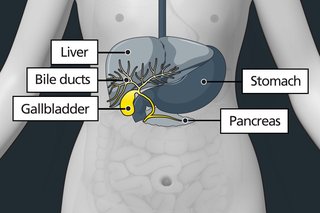Gallstones
The gallbladder is a small organ in the top part of your tummy that helps you digest your food.
Gallstones may be found in the gallbladder or the bile ducts, which are small tubes that connect the gallbladder to organs such as the liver and pancreas.

Multimedia Team - nhs.uk
Symptoms of gallstones
Gallstones are common and often do not cause symptoms. But if a gallstone blocks a bile duct (a small tube that connects the gallbladder to the liver and other organs), they can cause tummy pain.
The pain may:
- feel severe
- be constant
- last longer than 30 minutes, and up to several hours
- be in the middle of your tummy, or just under your ribs on the right side
- make you feel sick or vomit
This tummy pain is called a biliary colic.
Urgent advice: Ask for an urgent GP appointment or get help from NHS 111 if:
- you have pain in your tummy that lasts longer than 30 minutes
You can call 111 or get help from 111 online.
Immediate action required: Call 999 or go to A&E if:
- you have sudden, severe pain in your tummy
- you have pain that spreads from your tummy to your back, and are being sick
- your temperature is very high, or you feel hot, cold or shivery
- your skin or the white part of your eyes looks yellow
Do not drive to A&E. Ask someone to drive you or call 999 and ask for an ambulance.
Bring any medicines you take with you.
How gallstones are diagnosed
If you do not have symptoms, gallstones may be found by chance at a scan or X-ray for another health issue.
If you have symptoms of gallstones, you may have:
Treatment for gallstones
If you have gallstones, you might not need any treatment if they're not causing symptoms. You may need follow-up appointments with the doctor in the future to check the gallstones are not getting worse or causing problems.
You may need treatment if:
- you have symptoms of gallstones
- you have complications from gallstones
- gallstones are found in the common bile duct
The main treatment for gallstones is surgery to remove the gallbladder (cholecystectomy).
If gallstones are found in your common bile duct, you may have a procedure called endoscopic retrograde cholangio-pancreatography (ERCP) to clear the bile duct.
ERCP is done using a long, thin tube with a small camera inside, called an endoscope, which is passed into your stomach through your mouth. The opening of the bile duct is widened so the stones can pass through.
Waiting for surgery
While you're waiting for surgery, you may:
- take painkillers, such as paracetamol and ibuprofen
- be offered stronger painkillers for severe pain if you need it
- want to avoid foods that cause symptoms
- be advised to eat a low-fat diet
Find more dietary advice for patients with gallstones on the Cambridge University Hospitals website.
Complications of gallstones
Complications of gallstones are rare. But sometimes gallstones can cause a blockage which leads to serious complications such as:
- inflammation of the gallbladder (cholecystitis) or pancreas (pancreatitis)
- jaundice, which can cause your skin or the whites of your eyes to turn yellow, itchy skin, and darker pee and paler poo than usual – yellow skin may be less noticeable if you have brown or black skin
Treatment for complications caused by gallstones is usually pain relief and surgery to remove the gallbladder (cholecystectomy).
Check if you're at risk of gallstones
Gallstones are common. There are usually no symptoms, so you may not know you have them.
You may be more likely to get gallstones if:
- you're over 40 years old
- you're a woman
- you're living with obesity
- you have a diet that's high in fat and low in fibre
- you've lost weight quickly – for example, through weight loss surgery
- you have a condition such as diabetes or Crohn's disease
Video: gallstones
In this video, a doctor explains what gallstones are, the symptoms and the treatment options.
Media review due: 1 May 2027
Page last reviewed: 11 August 2025
Next review due: 11 August 2028